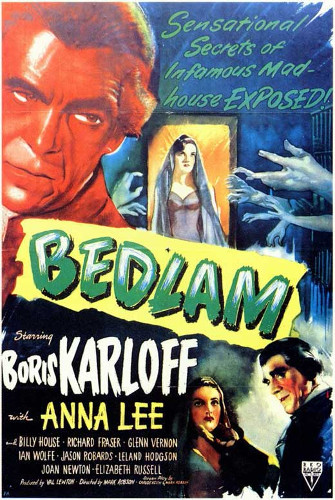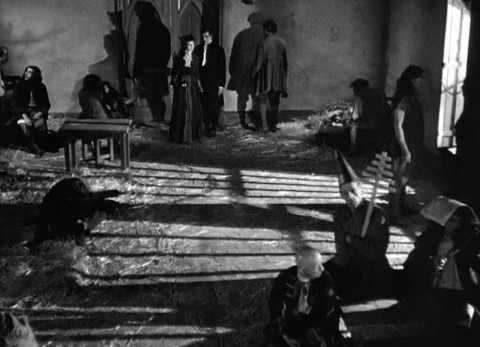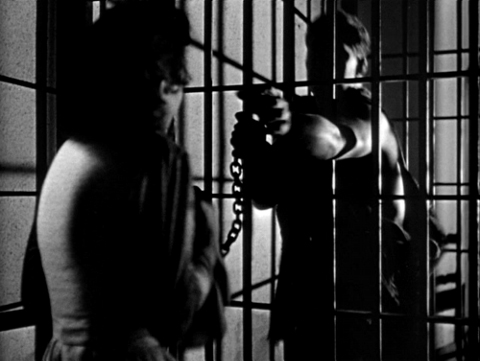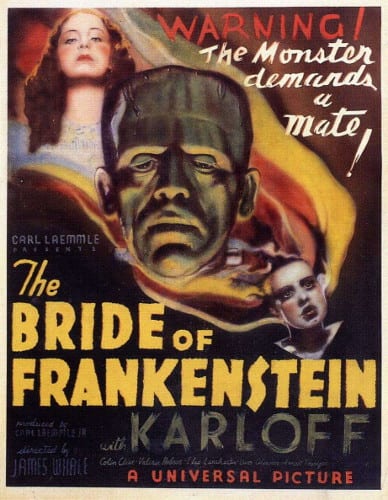Bedlam (1946)
Directed by: Mark Robson
Written by: Mark Robson, Val Lewton
Starring: Anna Lee, Billy House, Boris Karloff, Richard Fraser
USA
AVAILABLE ON DVD and DIGITAL
RUNNING TIME: 84 mins
REVIEWED BY: Dr Lenera

London 1761, St. Mary’s of Bethlehem Asylum. After an acquaintance of aristocrat Lord Mortimer dies in an attempt to escape from the place, apothecary general Master George Sims appeases Mortimer by having his “loonies” put on a show for him. Mortified by the treatment of the patients, Mortimer’s protégé Nell Bowen first tries unsuccessfully to persuade Mortimer to help, then seeks the help of Whig politician John Wilkes to reform the asylum, threatening Sim’s corrupt practices. Mortimer and Sims conspire to commit Nell to the asylum….

Nine years ago Channel 4 showed a four-part documentary called Bedlam which really opened my eyes about the subject of mental health and the insane. Only one episode was actually set in the modern version of the once notorious asylum Bethlem Royal Hospital aka Bedlam, well known for its terrible treatment of its patients until a quaker named Edward Wakefield paid several visits to the place and set in motion a campaign for reformation of the treatment of the mentally ill which, aided by the much publicised madness of King George III, did succeed in changing thing for the better. The ninth and last of the Val Lewton-produced and co-written horror films is a largely fictionalised version of events that led up to this change, but is still clearly inspired by them so it’s odd that the name of its asylum is now Bethlehem Asylum and two characters clearly based on Edward and Thomas Munro, the head physician who was accused of “wanting in humanity” towards his patients and was forced to retire, have their names changed – especially as the also-real John Wilkes retains his real name! It’s the most ‘un-Lewton’ like of all the Lewtons, being the most conventional in both visual style and the handling of its plot, and some may not even consider it to be a horror film at all, but don’t let this put you off seeing it; it’s a very fine period drama. Being quite forward thinking in the handling of its subject [the mentally ill often tended to be used as figures of fun or fear back then], and being a tale of a selfish, uncaring butterfly who becomes caring and a social progressive, it’s both compassionate and inspiring, while still telling an exciting story and being able to show off Boris Karloff at his most menacing – his ability to make your flesh creep without actually seeming to do very much is showcased brilliantly in this film.
Director Mark Robson read an article in a newspaper about ‘Tom o’ Bedlam’, a name given to ex-Bedlam residents who were given royal permission to beg on the streets. He told Lewton, who was inspired himself by the final picture of ‘A Rake’s Progress’, a series of eight paintings by William Hogarth. A Chamber Of Horrors: A Tale Of Bedlam was the original title. They were given a somewhat larger budget than the previous Lewtons because The Body Snatcher had done so well, though still used a church set from The Bells Of St. Mary’s, but their initial screenplay was rejected by the MPAA’s Joseph Breen who considered it to be “quite thoroughly and completely unacceptable”, “repellent and repulsive” and “outrageously shocking to normal people everywhere” . This was no doubt largely due to the subject matter, though he was willing to pass the script if many of the scenes involving the inmates be rewritten, suggestions of “illicit sex” be removed [though slight hints remain], and the finale be altered to lessen culpability in murder. Karloff suggested alterations to his dialogue, some of which were adopted, and even criticised Nell’s character arc, though more input from him always meant that he really liked a project, rather than the opposite. Lewton was a big art lover and was finally able to fully indulge himself, with some of Hogarth’s paintings given close recreations and even acting as scene transitions, though some versions of the film removed the latter. There’s even a scene where a Hogarth work is coming out of a printing press. A scene involving people trying to buy the parrot at a market, an elaborate transition using a Hogarth painting, and some dialogue weren’t filmed when RKO deemed that the production was eating up too much money. It didn’t make much money either, and some sources say that it was banned in the UK, but it seems that it was never actually submitted to the BBFC until 1998.
Paintings by Hogarth are even shown behind the credits, before we get into a tense opening scene with a man hanging from a gutter, obviously trying to escape, while a guard sees him and crushes his hands with his boot, causing him to fall to his death. Joining the ensuring commotion are Lord Mortimer riding in a carriage with his “protege” Nell Bowen. Well, that’s what Nell calls herself, and she also calls herself his “entertainer”. I did wonder if she’s supposed to be his – how should I say this? – young companion including in the bedroom what with lines like, “I have no need of their wit to entertain you, my lord”, though she later rebukes George Sims for suggesting such a thing so I’m confused. The MPAA probably muddied the issue. Anyway, it turns out that the guards at Bedlam mistook one of Mortimer’s friends for an inmate and he naturally fled them. He’s furious at George, Karloff getting another fine introductory shot with him sitting pensively on a chair outside Mortimer’s office like a naughty schoolboy awaiting the pleasure of his headmaster, after which Mortimer’s son [I think – we have here another character whose relationship to Mortimer is vague] pulls faces in a mirror and says “I want to look like the visitor in the hallway”. No wonder Karloff loved working with Lewton. George has to make it up to Mortimer so invites him to a play performed by his inmates. Nell’s also up for this, and even wants “to see the loonies in their cages” , so George takes her into a room at the asylum where the camera pans out and rises to show the “loonies” in all their awful squalor. We feel a little scared, and that’s right, because we are seeing these people from the point of view of Nell. “They’re all so lonely, they’re all in themselves of by themselves” says Nell who feels some sympathy, something evoked beautifully by Anna Lee whose performance in this is perfectly pitched all the way through.

Anna reverts to type when back with Mortimer, as well as her ‘posh’ way of speaking which is clearly being put on, but is outraged when ‘performers’ at the ‘play’ are just there to be mocked and one of them collapses from suffocation from the paint George put on him, a scene where the actor playing him nearly passed out for real for the same reason until Karloff noticed and called a nurse. Nell turns on both George and Mortimer, even teaching the parrot to insult Mortimer so that he tries to buy him in an amusing little section, but pays for this by being committed to Bedlam herself while Mortimer replaces her with his niece who also seems to be a prostitute [very subtly hinted at]. Elisabeth Russell seems a little ill at ease in her final Lewton appearance though I still wished she was in it more, she has such a strange and powerful screen presence, as does Skelton Knaggs who again is given little to do yet your eyes are drawn to him anyway. Nell is terrified and insists on being given a weapon which soon disappears, though it’s re-appearance is a perfect example of neat plotting. But she keeps her sanity by remaining among “the people of the pillar” who are more ‘with it’ than the others. And she’s soon providing care for those others who are used to just chains, beatings, mockery and neglect. George seems happy to give Nell what she needs out of sheer amusement, but thinks nothing of getting her to enter a cage containing a supposedly dangerous brute in a really fine scene where he taunts her to go in so that his belief that “there’s is a bestial world, without reason, without soul” will be proven by the occupant attacking her. Instead, he’s proven wrong, and Nell is considered an “angel” like Sarah in Hammer’s Frankenstein And The Monster From Hell which was clearly inspired by this movie. Things climax with a great kangaroo court sequence and a variation on Edgar Allan Poe’s The Black Cat, with George’s fate far more dramatic then his real-life counterpart, in a a film where, oddly for the time, murder isn’t punished despite the censor-mandated changes!
There’s some humour found in the inmates without being insulting. During the trial one inmate keeps crying “I’ll split ‘im in two!” and we can only agree. I also really liked the alcoholic writer who’s been put in the asylum by his family so he can write and support them, and the man who not just thinks that he’s a top lawyer but shows the art of animation and by dent movies – and is told that he really needs to be locked up. The screenplay for this is sometimes really knowing without seeming forced. And then there’s the woman who just stands and stares while George greets her by stroking her cheek, something which surely hints at rape, though the character gets a moment at the end where you feel like cheering despite the violence of the act. Of course we don’t see much of what George is doing to his patients but we get the idea of it, and by god Karloff is creepy as he delivers lines like “all who lose their trip on gutters must fall”, yet his character gets a scene near the end where he explains that he’s only barbaric in this way that he is so he can keep his job. It’s scum like Mortimer who are probably even worse, calling the shots in a cruel world where it’s all about money and courting favour. The system is rotten. Thankfully as well as Nell we have ‘The Stonemason’, the character who’s clearly inspired by the crusading Edward Wakefield, helping her out and filling the role of a potential love interest. He represents Christianity in its best form, yet he ends up going along with something that’s clearly wrong to him, which is a bit subversive. Richard Fraser is bland in the role, but we’re now so used to these romantic interest characters being bland it doesn’t really matter. He gets given a ‘Lewton bus’ moment where he walks along a corridor and a hand reaches out of a cage to nearly touch him, followed by a shot of a cackling hag. It’s maybe at odds with the sensitivity shown elsewhere to the issue of the mad, but was probably felt needed to be included.
Indeed this film, despite having Nicholas Musuraca – who photographed four earlier Lewtons – return to cinematographic duties, has very little of the usual Lewton stylistics, despite containing one tremendous shot where Nell is in the room where all the ‘lunatics’ are and all around her is dark while she’s composed of equal parts black and white, though maybe it’s appropriate seeing as this one is loosely based on fact and therefore doesn’t take place in the world of cat people, satanists and ghost ships. There’s more of Roy Webb’s music than usual though; suitable dramatic while never overdoing things. His theme for Nell evokes her almost saintliness and period harmonies are nicely intermingled in places. But it’s possible that Bedlam was quite a personal project for Lewton because it seems so sincere and heartfelt as well as unusually positive, made as it was while World War 2 was ending. Sadly Lewton’s career afterwards wasn’t very long and wasn’t very successful. Personnel and management upheavals left him unemployed and in ill health after suffering a minor heart attack. He failed to start an independent production company with former protégés Robert Wise and Robson, and employment at Paramount and MGM usually resulted in his scripts being taken off him and only three producing credits. He started to work as an assistant producer for the bigwig Stanley Kramer, but after suffering gallstone problems, he had the first of two heart attacks which weakened him so much that, the age of 46, he died. The following year, Kirk Douglas’s character Jonathan Shields in The Bad and the Beautiful was partly based on Lewton. He left behind a legacy of nine incredibly rich contributions to the horror genre that will continue to chill and fascinate.
Rating: 









So it’s the end of his Val Lewton write-ups, but Doc will be going through another franchise soon, a science fiction franchise that began in 1968 and spans five decades!





Be the first to comment